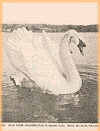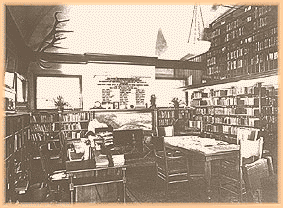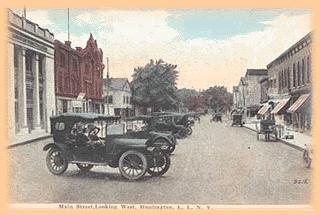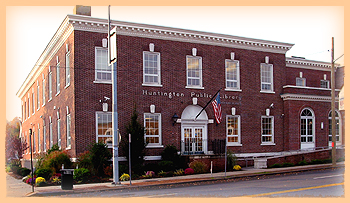20th Century History of the Huntington Public Library
1900-1958
| courtesy of the SUNY Stonybrook Historic Postcard Collection |

|
At the turn of the century, the Huntington Library Association had 5,078 volumes on its shelves. In 1899, it had loaned 5,800 books. It had thirty-nine life members and paid a yearly rent of $25. to the Memorial Association.
In March, 1900, the association gave a "grand entertainment and supper" in the Opera House to celebrate its twenty-fifth anniversary. Along with piano performances and speeches, a historical address, written by Mr. Edmund B. Davidson, brother of Mrs. Mary Talmage was presented.
Ms. Mary F. Gaines had been appointed librarian after Mrs. Addie S. Conklin retired in 1897. She held that position until 1920, during which time the circulation of the library increased four-fold. Mrs. Gaines was a retired school teacher who was dedicated to attracting children to the library and encouraging young and old, alike, to read. In 1902, a child could borrow a book for two weeks at a cost of two cents per week. She re-catalogued the and re-shelved the children's books according to subject. She was also in charge of attending the furnace until 1903.

A coincidence? This postcard, labelled:"Old Tom Huntington Harbor, L.I." was found in the SUNY Stonybrook Collection.
In 1909, the Tower room was outfitted with shelving, heating and lighting and was reserved for reference work. The new International Encyclopedia was added to Britanica on the reference shelves and was consulted by scores of people. Mr. Temple Prime donated $3500. to cancel the debt still owed from the construction of the memorial building.
In 1916, Mrs. Gaines reported that circulation for the year decreased "which I attribute in great measure to moving pictures, athletics and perhaps automobiles have something to do with it as the greatest decrease is shown in the juvenile and fiction reading"
During World War I, libraries were asked to provide books for the soldiers and the Huntington Public Library did its part by providing them with duplicate books and magazines.
On August 29, 1929, the Huntington Public Library was created when a vote by the taxpayers approved "a tax upon the taxable property of Union School District No. 3 the sum of $14,000 for Public Library purposes". This same year the library received its charter as a Free Public Library from the University of the State of New York.
Also in 1929, the Huntington Station branch was opened. A building was leased for that purpose from W. Wilton Wood on 1351 New York Ave. Dr. Theodore Lyman Frost was hired to take charge of the Station branch. Dr. Frost was pastor of the First Presbyterian Church of Greenlawn and had received degrees from Harvard, Rochester Theological Seminary, Temple University and his Library Service degree from Columbia University. The branch library, under Dr. Frost's supervision grew faster than the Village Branch until the late 1950's.
After the retirement of Miss Irene Hacket, a graduate of Pratt Institute, who had served as librarian from 1925-1930, Dr. Frost was hired as librarian for the whole of the Library. Under his guidance and efficiency the number of borrowers grew from 3,062 in 1929 to 4,215 in 1932.
In these early days, the staff consisted of Dr. Frost and seven female assistants. The training of these assistants became a top priority for Dr. Frost. In 1930, Dr. Frost began to conduct, single handedly, a course of studies covering all phases of library study for his stafff. This was a three year program (Oct.-May) that was regarded highly. Upon examination of the courses by the Library Extension Division of the University of New York gave certification to all those who successfully completed the program. These courses continued until 1942 when libraries were put under the Civil Service Department.
The thirties were difficult years due to the depression but some of the events noted by Dr. Frost include:
- 1931-32 Vertical files were installed for printed matter, other than books.
- 1934-35 A new mezzanine floor was installed and became the children's section.
- 1935 Six hundred dollars was appropriated to build up the "Long Island Historical Collection, since many patrons were interested in historical research and genealogy.
- 1937 Dr. Frost prepared the program and offered the words of welcome at the Long Island Regional Institute of the Univ. of the State of New York. The institute was held in the Parish Hall of Grace Chapel in Huntington Station. One hundred and twenty-three people from all of the Long Island libraries and the large New York city libraries attended.
- 1938 A committee was established to reconcile the needs of the schools with the holdings of the library
- 1939 Duplicate books were sent to the Huntington Hospital Library
The forties also proved to be lean years for the library. The effects of the war economy, the lack of personnel, and the patrons working in the factories, saw decreased circulation and funds. Some of the more significant highlights of those years include:
- Huntington's Victory Book Drive for the armed forces gathered 6,000 volumes for the servicemen.
- Books on victory gardens, poultry farming, raising rabbits for food and "how-to-do-it-yourself" books were in great demand.
- The library joined the New York Civil Service Department and Dr. Frost prepared the materials needed for his staff to take the Civil Service examinations.

On January 3, 1946, a fire broke out in the basement of the Village library. All the materials in the basement were destroyed, as well as $700. worth of books and $300. worth of magazines and reference materials. The smoke damage left the library unusable and temporary quarters were found at the Odd Fellows Hall, 16-18 Wall St. Dr Frost voiced his objections to the site in the Long Islander. He believed the many "drinking establishments" nearby made the site unsavory. In answer, the library Board passed a motion that no member of the library's staff could voice an opinion on the library without the Board's approval. That summer, the library was served a notice of eviction and in August 1946, Dr. Frost issued his letter of resignation.
| courtesy of the SUNY Stonybrook Historic Postcard Collection |

|
The repair of the Soldier's and Sailor's Memorial Building was completed in Oct. 1946, but the building could not adequately house the library's 20,000 volumes and the town-wide search for a new building began.
Mrs. Elizabeth Bently Scheffler was hired temporarily as librarian. Mrs Scheffler had received degrees from Syracuse and Bucknell Universities. She had experience in setting up libraries for the U.S. Federal Government and overseas. In her very short tenure Mrs. Scheffler reorganized the staff and made significant recommendations to increase programs and services. The first weekly children's story hour and summer reading programs were instituted under her direction.
In 1949, Charles F. McDonald became Library Director. He was a graduate of Princeton and the Columbia Graduate Scool of Library Science. Mr. McDonald made significant contributions during his years at Huntington Public Library, none more so than in the area of publicising the library. These included:
- Distributing a summarized version of the annual report to patrons.
- Printing bookmarks, booklists, and booklets on library usage, ie:"How to Use the Card Catalog" and "How to find Out: the Key to Library Serice"
- Expanding the column:"Library Notes" in the Long Islander to include more specialized services.
- Began a reading and storytelling program at Heckscher Park in connection with the YMCA day camp.
In the meantime, a search for a new library building continued. A "Friends of the Library Group" was established with a special committee for that purpose, namely, the "Citizen's Committee for a New Library Building Program".
The New York Telephone Company had recently moved out of its old office building on the corner of 338 Main St. and Prospect St., and this building was offered for sale. Due to the efforts of the Friend's Group, the Board of Trustees and other community organizations, a proposition was passed on April 15, 1957 to buy the Telephone Company Building for the new home of the Huntington Public Library.
Before the move to the new building, Mr. Charles F. McDonald resigned and Mr. Stanley A. Ransom was appointed Acting Librarian.
On June 30, 1958, the new library building was open to the public after a move and dedication that involved the patrons in unusual and delightfully innovative ways. The Junior Chamber of Commerce volunteered to transport the furniture, but the question remained: "How to move the 30,000 library books the three blocks from the Memorial Building to the new library?" The answer lay with the citizens of Huntington. The Bank of Huntington donated 3,000 shopping bags to this cause. The library staff placed ten books in each bag and labeled them to keep the books in order. . Droves of girl scouts, boy scouts and regular library patrons made many trips carrying the bags of books to the new building. This moving of the books was accomplished in two and a half days, without the loss of a single volume. The dedication, held on July 6, 1958, given by Rev. Dr. William S. Hess, pastor of the Old First Church in Huntington used a litergy that enabled the entire community to take part.
| 1958 Dedication Program for the New Huntington Public Library Building |
| (*Audience will rise where marked with asterisk) |
| I. WELCOME |
| II. INVOCATION: Rabbi Joseph H. Lief |
| III. Supervisor: Mr. Ernest W. Johnson |
| IV.ACT OF DEDICATION: Rev. Dr. William S. Hess |
| Dr. Hess: For making available the accumulated wisdom of the ages for the education of the people of this community, |
| The People: We dedicate this building. |
| Dr. Hess: For providing information for the use of the citizens of this community in all phases of life, |
| The People: We dedicate this building. |
| Dr. Hess: To provide facilities for recreational reading and entertainment, |
| The People: We dedicate this building. |
| Dr. Hess: To fulfill the needs of the adult population and to provide them with opportunities for personal development, |
| The People: We dedicate this building. |
| Dr. Hess: To provide materials for research and study for the students and scholars in the community, |
| The People: We dedicate this building. |
| For the opening of the mids and the quickening of the interest of the children, |
| The People: We dedicate this building. |
| For the use of the people of all groups, creeds and races. |
| The People: We dedicate this building. |
| * Prayer: Dr. Hess |
| V. REMARKS: Mr. Harold Darling |
| *BENIDICTION: Rev. William J. Remey |

| to be continued..... |
| "I know that the past was great and the future will be great, |
| and I know that both curiously conjoint in the present time" |
| Walt Whitman (1819-1892) |

